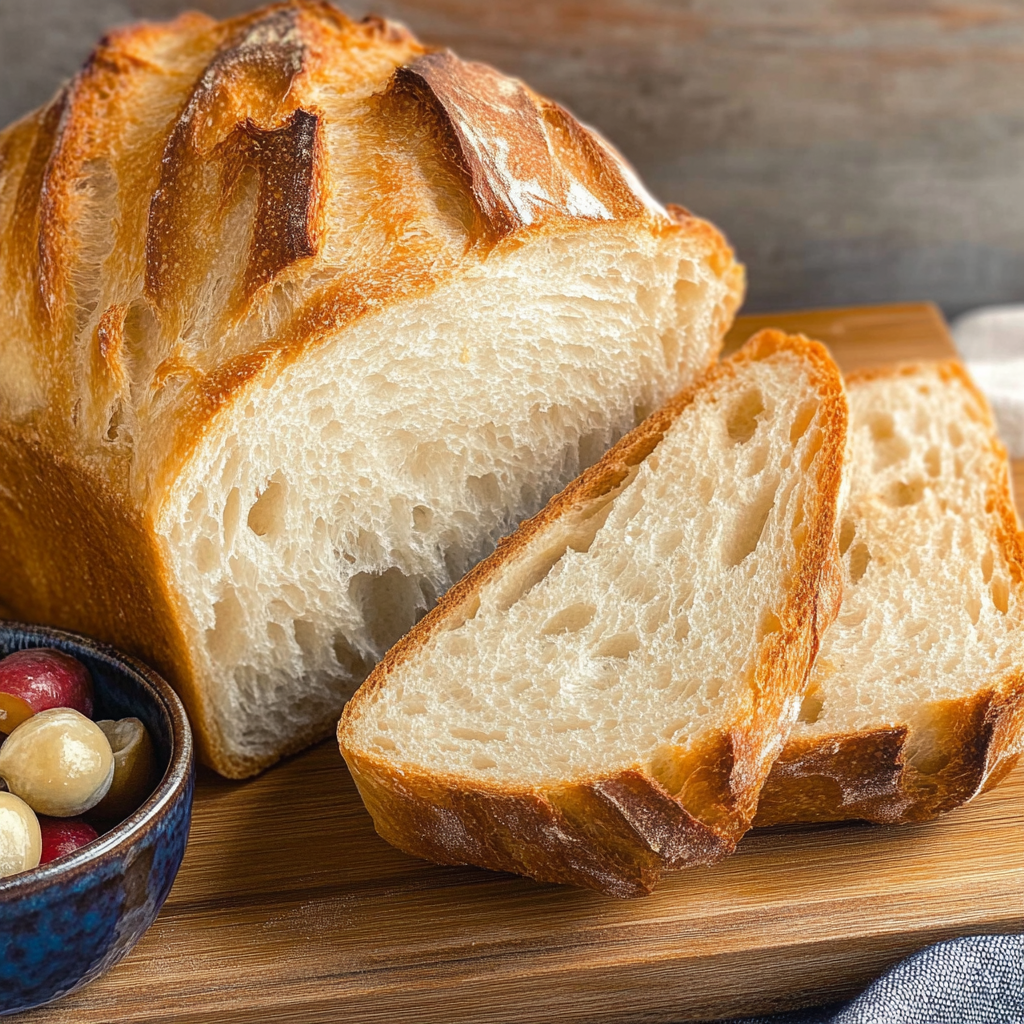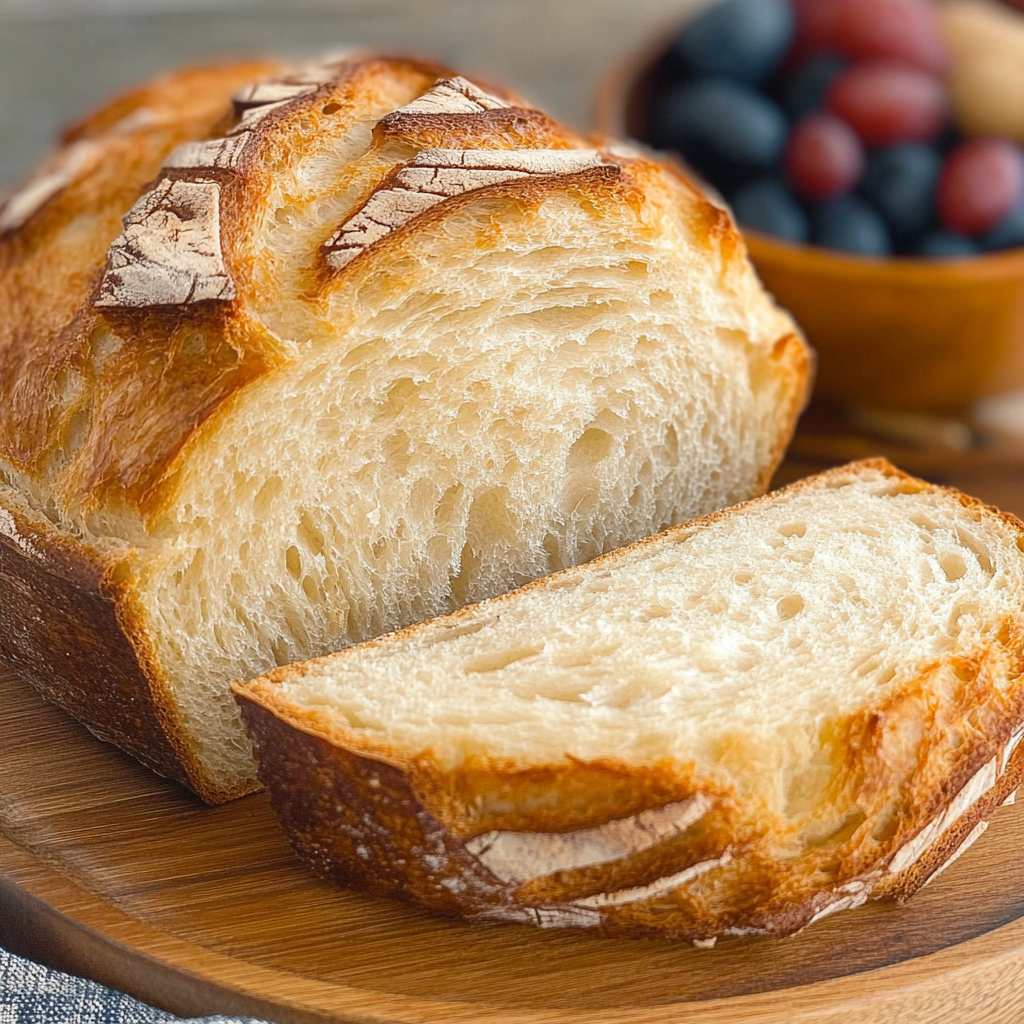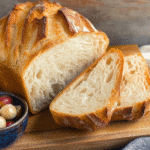A crusty loaf of sourdough bread fresh from the oven is like a warm hug on a chilly day. Imagine that first bite: the crackling crust giving way to a soft, airy interior, with tangy notes dancing on your palate like they just won the lottery. The aroma fills your kitchen, wrapping around you like a cozy blanket, making it impossible to resist.

Now, let’s get real for a moment. I remember the first time I attempted to make sourdough bread. Let’s just say my dough had more personality than I did that day. It was an adventure filled with flour explosions and a few choice words that would make my grandmother clutch her pearls. But oh, the satisfaction when it finally came out of the oven! Perfect for brunch, dinner, or even as a midnight snack (not that I’m judging). Trust me; this sourdough bread recipe will have you feeling like a baking superstar in no time.
Why You'll Love This Recipe
- This sourdough bread is surprisingly easy to make once you get the hang of it
- With its complex flavor profile, it elevates any meal from ordinary to extraordinary
- The beautiful golden crust and fluffy interior make it visually stunning and irresistible
- Plus, it’s incredibly versatile—perfect for sandwiches, toast, or simply slathered with butter
Ingredients for Sourdough Bread
Here’s what you’ll need to make this delicious dish:
- All-Purpose Flour: Use high-quality flour for better gluten development; this helps achieve that perfect chewy texture.
- Water: Filtered water at room temperature is best; it helps create the ideal environment for yeast activity.
- Sourdough Starter: A live culture full of wild yeast and bacteria; ensure it’s active and bubbly before using.
- Salt: Sea salt works wonders in enhancing flavor without overpowering the natural tang of the sourdough.
The full ingredients list, including measurements, is provided in the recipe card directly below.

How to Make Sourdough Bread
Follow these simple steps to prepare this delicious dish:
Step 1: Prepare Your Sourdough Starter
Begin by feeding your sourdough starter about four hours before you plan to mix your dough. Make sure it’s bubbly and active.
Step 2: Mix Dough
In a large mixing bowl, combine 500 grams of all-purpose flour with 350 grams of water and 100 grams of active sourdough starter. Mix until there are no dry bits left.
Step 3: Autolyse
Let your dough rest for about 30 minutes. This process allows the flour to absorb water fully and starts gluten development without added salt yet.
Step 4: Add Salt
After resting, sprinkle in 10 grams of salt and mix until fully incorporated into the dough. You can use your hands or a spatula; just be sure it’s mixed well.
Step 5: Bulk Fermentation
Cover the bowl with a damp cloth or plastic wrap and let it sit at room temperature for about four hours. Every hour during this period, gently stretch and fold your dough in the bowl to develop strength.
Step 6: Shape and Proof
After bulk fermentation, gently turn out your dough onto a floured surface. Shape it into a round loaf and place it seam-side up in a floured banneton (a proofing basket) or bowl lined with parchment paper. Cover and let proof for another two hours at room temperature or overnight in the fridge if you prefer!
When you’re ready to bake, preheat your oven to 450°F (230°C) with a Dutch oven inside for about half an hour beforehand. Bake your loaf covered for 30 minutes then uncover for an additional 15-20 minutes until golden brown.
Transfer to plates and enjoy warm slices drizzled with olive oil or topped with creamy butter!
You Must Know
- This delightful sourdough bread recipe transforms mere flour and water into something magical
- The crust is golden, the crumb is airy, and the smell?
- Oh, it’s like a bakery exploded in your kitchen
- Perfect for sandwiches, toast, or just plain munching!
Perfecting the Cooking Process
Start by mixing your sourdough starter with flour and water, allowing it to ferment overnight. Shape the dough in the morning, let it rise for a few hours, then bake until golden brown. This sequence maximizes flavor and texture.
Add Your Touch
Feel free to swap out some of the white flour for whole wheat or rye for a nutty flavor. Add herbs like rosemary or garlic for a savory twist. The possibilities are endless when making sourdough bread!
Storing & Reheating
Store your sourdough bread in a paper bag at room temperature for up to three days. For longer storage, slice and freeze. Reheat slices in a toaster or wrap the loaf in foil and warm it in the oven.
Chef's Helpful Tips
- Keep your sourdough starter active by feeding it regularly; this ensures robust fermentation
- Don’t rush the rising time; patience yields better flavor and texture
- If you want a crispier crust, add steam to your oven during baking
When I first baked sourdough bread, my family devoured it faster than I could slice it! Their compliments made me feel like a culinary magician, conjuring up deliciousness with just flour and water.
FAQs :
What is Sourdough Bread?
Sourdough bread is a unique type of bread that relies on naturally occurring yeast and bacteria for fermentation. Unlike regular bread, which often uses commercial yeast, sourdough develops a complex flavor profile due to this natural fermentation process. The starter, made from flour and water, captures wild yeast from the environment. This gives sourdough its distinct tangy taste and chewy texture. Many people prefer sourdough due to its health benefits, including improved digestion and lower glycemic index compared to other bread types.
How do I store Sourdough Bread?
To keep your sourdough bread fresh, store it in a paper bag at room temperature for up to 3 days. Avoid plastic bags as they trap moisture and can make the crust soggy. If you want to store it longer, consider wrapping it in aluminum foil or plastic wrap and placing it in the freezer. This way, you can preserve its flavor and texture for several weeks. When ready to eat, simply thaw it at room temperature or warm it in the oven for a few minutes to restore its crusty exterior.
Can I use whole wheat flour for Sourdough Bread?
Yes, you can use whole wheat flour in your sourdough bread recipe. Whole wheat flour adds a nutty flavor and increases the nutritional value of the bread by providing more fiber and nutrients than white flour. However, using entirely whole wheat flour may lead to denser bread. A common approach is to mix whole wheat with all-purpose flour for better texture while still benefiting from the wholesome qualities of whole grains.
Why is my Sourdough Bread not rising?
If your sourdough bread isn’t rising well, several factors could be at play. First, check the vitality of your starter; it should be bubbly and active before using it in your recipe. Additionally, ensure that you are allowing adequate time for bulk fermentation, as this step is crucial for building structure. Temperature also plays a vital role; warmer environments encourage better yeast activity. Lastly, make sure you’re using enough water in your dough; hydration affects how well the dough expands during proofing.
Conclusion for Sourdough Bread :
Sourdough bread stands out due to its unique flavor profile and health benefits derived from natural fermentation. Understanding how to properly store it ensures that you enjoy its delightful taste for longer periods. Whether you choose to incorporate whole wheat flour or troubleshoot rising issues with your dough, mastering sourdough can elevate your baking skills significantly. Embrace the process of making this timeless bread and savor each delicious slice with confidence!

Sourdough Bread
- Total Time: 1 hour 15 minutes
- Yield: Approximately 12 servings 1x
Description
Sourdough bread is a delightful blend of simplicity and complexity, offering a crispy crust that hides a soft, tangy interior. This homemade version elevates any meal, whether it’s served with butter for breakfast or as the base for gourmet sandwiches. Perfect for beginners and seasoned bakers alike, this recipe will have your kitchen smelling heavenly and your taste buds dancing in delight.
Ingredients
- 500 grams all-purpose flour
- 350 grams filtered water
- 100 grams active sourdough starter
- 10 grams sea salt
Instructions
- Feed your active sourdough starter four hours before mixing.
- In a large bowl, combine flour, water, and starter; mix until no dry bits remain.
- Let the dough rest for 30 minutes (autolyse).
- Add salt and mix thoroughly until fully incorporated.
- Cover and let the dough rest at room temperature for four hours, stretching and folding every hour.
- Shape the dough into a round loaf and place seam-side up in a floured banneton. Let it proof for two hours or overnight in the fridge.
- Preheat the oven to 450°F (230°C) with a Dutch oven inside for half an hour. Bake covered for 30 minutes, then uncover and bake for an additional 15-20 minutes until golden brown.
- Prep Time: 30 minutes
- Cook Time: 45 minutes
- Category: Bread
- Method: Baking
- Cuisine: General
Nutrition
- Serving Size: 1 serving
- Calories: 130
- Sugar: 0g
- Sodium: 200mg
- Fat: 0g
- Saturated Fat: 0g
- Unsaturated Fat: 0g
- Trans Fat: 0g
- Carbohydrates: 27g
- Fiber: 1g
- Protein: 4g
- Cholesterol: 0mg



